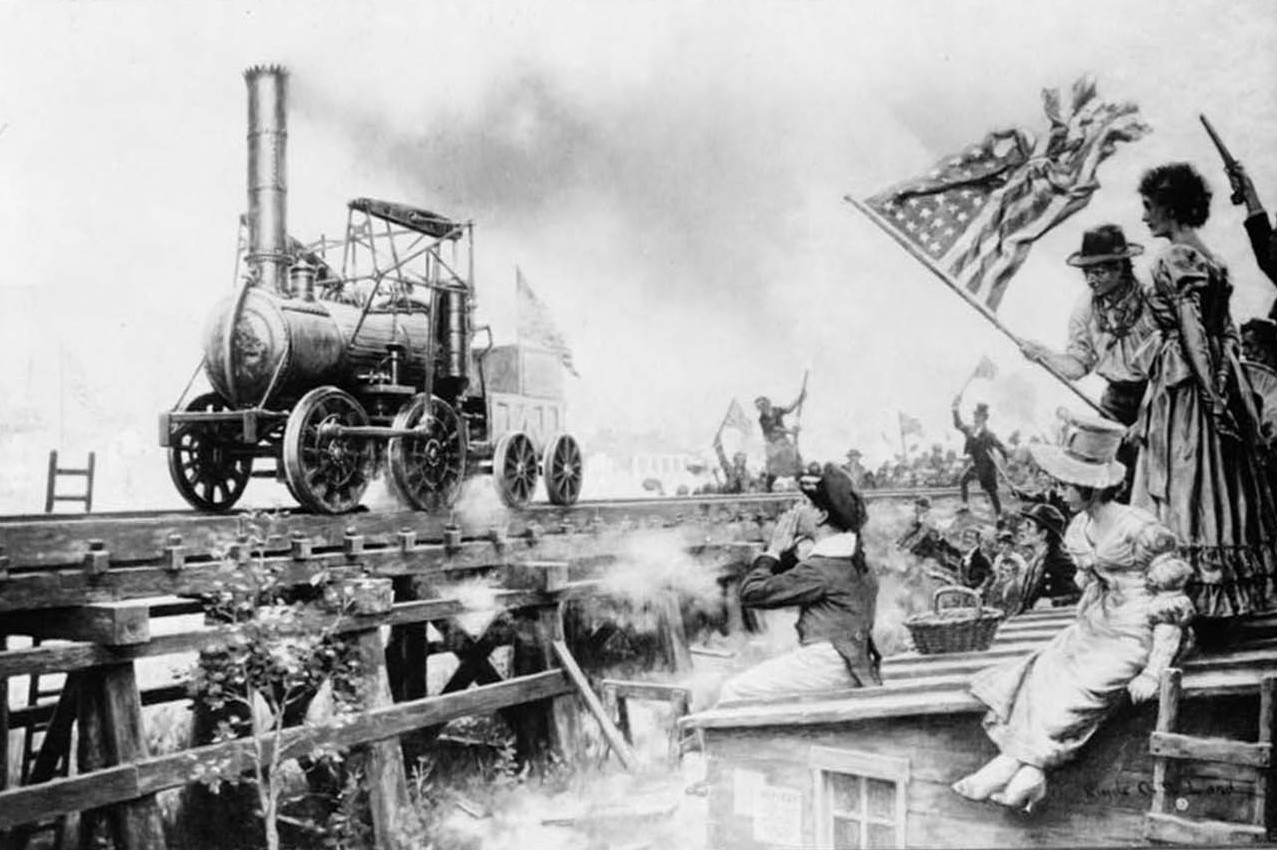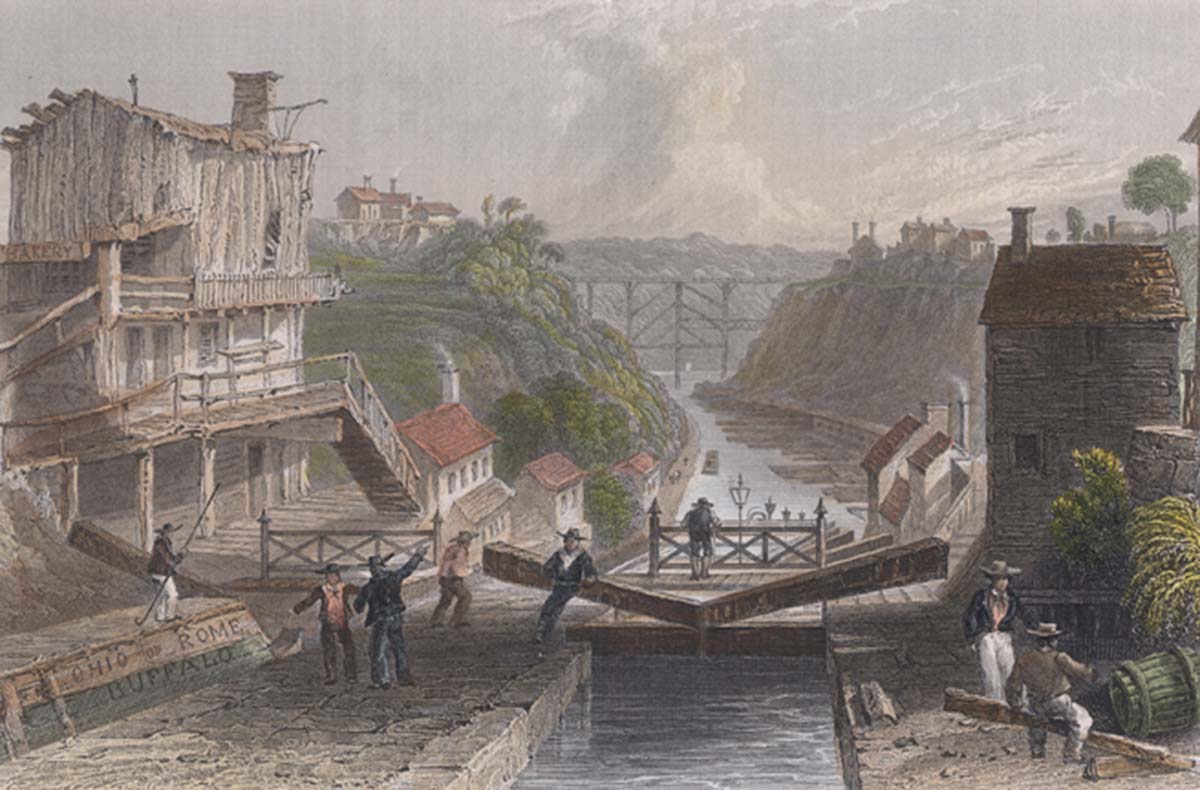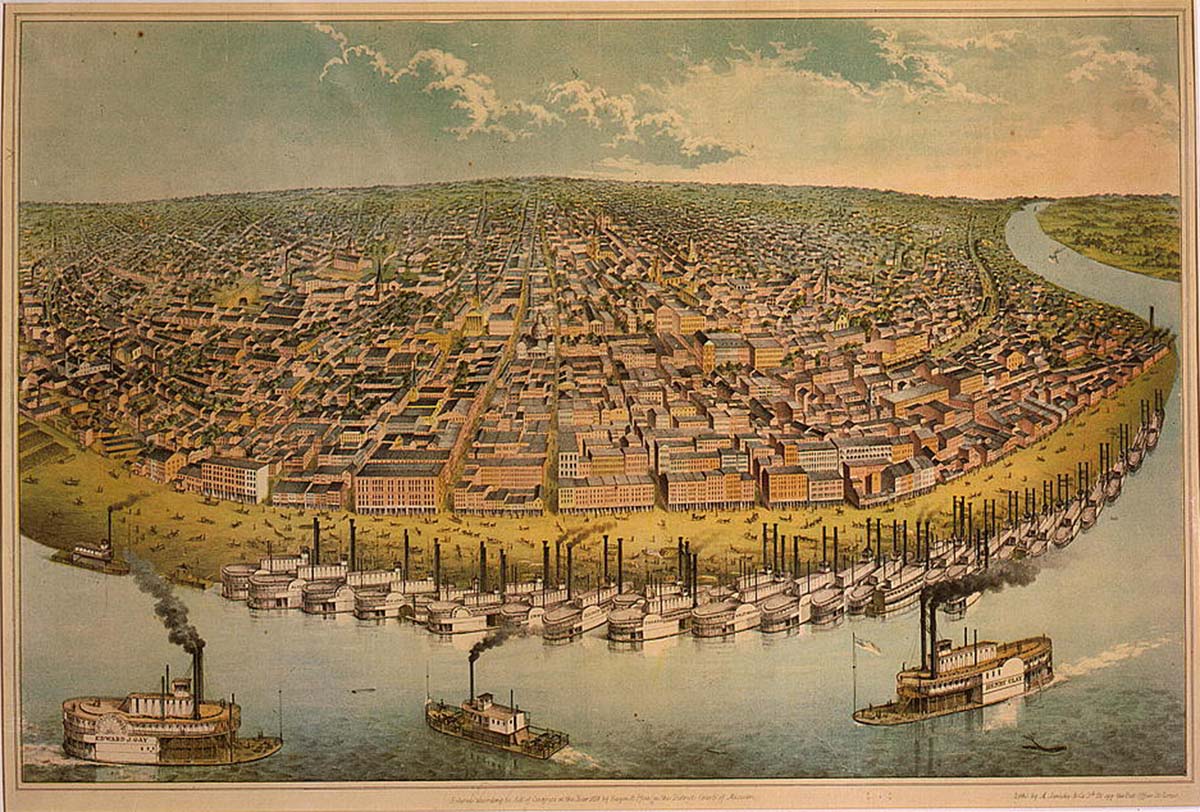Learning Objectives
- Describe the development of improved methods of nineteenth-century domestic transportation
- Identify the ways in which roads, canals, and railroads impacted Americans’ everyday lives in the nineteenth century
American Commerce
The growth of the American economy reshaped daily life in the decades before the Civil War. Americans increasingly produced goods for sale, not for consumption. With a larger exchange network connected by improved transportation, the introduction of labor-saving technology, and the separation of the public and domestic spheres, the market revolution fulfilled expectations of progress but introduced troubling new trends. Class conflict, child labor, accelerated immigration, and the expansion of slavery followed. These strains required new family arrangements and forged new urban cultures.
American commerce had proceeded haltingly during the eighteenth century. American farmers increasingly exported foodstuffs to Europe as the French Revolutionary Wars (also called the Napoleonic Wars) devastated the continent between 1793 and 1815. America’s exports rose in value from $20.2 million in 1790 to $108.3 million by 1807. But while exports rose, exorbitant internal transportation costs hindered substantial economic development within the United States. In 1816, for instance, $9 could move one ton of goods across the Atlantic Ocean, but only 30 miles across land. An 1816 Senate Committee Report lamented that “the price of land carriage is too great” to allow the profitable production of American manufactures. But in the wake of the War of 1812, Americans rushed to build a new national infrastructure, including networks of roads, canals, and railroads. In his 1815 annual message to Congress, President James Madison stressed “the great importance of establishing throughout our country the roads and canals which can best be executed under national authority.” State governments continued to sponsor the greatest improvements in American transportation, but the federal government’s annual expenditures on internal improvements climbed to a yearly average of $1,323,000 by Andrew Jackson’s presidency.

Figure 1. Clyde Osmer DeLand, “The First Locomotive. Aug. 8th, 1829. Trial Trip of the “Stourbridge Lion,” 1916.
State legislatures meanwhile pumped capital into the economy by chartering banks and the number of state-chartered banks skyrocketed from 1 in 1783, 266 in 1820, 702 in 1840, to 1,371 in 1860. European capital also helped to build American infrastructure. By 1844, one British traveler declared that “the prosperity of America, her railroads, canals, steam navigation, and banks, are the fruit of English capital.”
Economic growth, however, proceeded unevenly. Depressions devastated the economy in 1819, 1837, and 1857. Each followed rampant speculation—bubbles—in various commodities: land in 1819, land and enslaved persons in 1837, and railroad bonds in 1857. But Americans refused to blame the logic of their new commercial system for these depressions. Instead, they kept pushing “to get forward.”
The Transportation Revolution
The so-called Transportation Revolution opened up the vast lands west of the Appalachian Mountains. In 1810, for instance, before the rapid expansion of American infrastructure, a traveler named Margaret Dwight left New Haven, Connecticut, in a wagon headed for the Ohio Territory. Her trip was less than 500 miles but took six full weeks to complete. The journey was a terrible ordeal, she said. The roads were “so rocky & so gullied as to be almost impassable.” Ten days into the journey, at Bethlehem, Pennsylvania, Dwight said “it appeared to me that we had come to the end of the habitable part of the globe.” She finally concluded that “the reason so few are willing to return from the Western country, is not that the country is so good, but because the journey is so bad.” Nineteen years later, in 1829, English traveler Frances Trollope made the reverse journey across the Allegheny Mountains from Cincinnati to the east coast. At Wheeling, Virginia, her coach encountered the National Road, the first federally funded interstate infrastructure project. The road was smooth and her journey across the Alleghenies was a scenic delight. “I really can hardly conceive a higher enjoyment than a botanical tour among the Alleghany Mountains,” she declared. The ninety miles of National Road was to her “a garden.”
If the two decades between Margaret Dwight’s and Frances Trollope’s journeys transformed the young nation, the pace of change only accelerated in the following years. If a transportation revolution began with improved road networks, it soon incorporated even greater improvements in the ways people and goods moved across the landscape, including canals, steamboats, and railroads.
Roads and Canals

Figure 3. Although the Erie Canal was primarily used for commerce and trade, in Pittsford on the Erie Canal (1837), George Harvey portrays it in a pastoral, natural setting. Why do you think the painter chose to portray the canal this way?
One key part of the transportation revolution was the widespread building of roads and turnpikes. In 1811, construction began on the Cumberland Road, a national highway that provided thousands with a route from Maryland to Illinois. The federal government funded this important artery to the West, beginning the creation of transportation infrastructure for the benefit of settlers and farmers. Other entities built turnpikes, which (as today) charged fees for use. New York State, for instance, chartered turnpike companies that dramatically increased the miles of state roads from one thousand in 1810 to four thousand by 1820. New York led the way in building turnpikes.
Canal mania swept the United States in the first half of the nineteenth century. Promoters knew these artificial rivers could save travelers immense amounts of time and money. Even short waterways, such as the two-and-a-half-mile canal going around the rapids of the Ohio River near Louisville, Kentucky, proved a huge leap forward, in this case by opening a water route from Pittsburgh to New Orleans. The preeminent example was the Erie Canal, which linked the Hudson River, and thus New York City and the Atlantic seaboard, to the Great Lakes and the Mississippi River Valley.
With its central location, large harbor, and access to inland markets via the Hudson River, New York City already commanded the lion’s share of commerce. Still, the city’s merchants worried about losing ground to their competitors in Philadelphia and Baltimore. Their search for commercial advantage led to the dream of creating a water highway connecting the city’s Hudson River to Lake Erie and markets in the West, resulting in the Erie Canal. Chartered in 1817 by the state of New York, the canal took seven years to complete. When it opened in 1825, it dramatically decreased the cost of shipping while reducing the time to travel to the West. Soon $15 million worth of goods (more than $200 million in today’s money) was being transported on the 363-mile waterway every year.
Link to learning
Explore the Erie Canal on ErieCanal.org via an interactive map. Click throughout the map for images of and artifacts from this historic waterway.
Listen to the 1905 song “Fifteen Miles on the Erie Canal,” written after engine power replaced the hard-working mules that had pulled the barges, allowing them to travel more than just fifteen miles per day. The song talks about a canal worker’s friendship with his mule, Sal.
The success of the Erie Canal led to other similar projects. The Wabash and Erie Canal, which opened in the early 1840s, stretched over 450 miles, making it the longest canal in North America. Canals added immensely to the country’s sense of progress. Indeed, they appeared to be the logical next step in the process of transforming wilderness into civilization.

Figure 4. This map (a) shows the route taken by the Wabash and Erie Canal through the state of Indiana. The canal began operation in 1843 and boats operated on it until the 1870s. Sections have since been restored, as shown in this 2007 photo (b) from Delphi, Indiana. Visit Southern Indiana Trails to see historic photographs of the Wabash and Erie Canal:
As with highway projects such as the Cumberland Road, many canals were federally sponsored, especially during the presidency of John Quincy Adams in the late 1820s. Adams, along with Secretary of State Henry Clay, championed what was known as the American System, part of which included plans for a broad range of internal transportation improvements. Adams endorsed the creation of roads and canals to facilitate commerce and develop markets for agriculture as well as to advance settlement in the West. Along with these commerce-enabling infrastructural investments, the American System also featured a national bank and a program of tariffs to protect domestic manufacturing.
Steamboats
Robert Fulton established the first commercial steam boat service up and down the Hudson River in New York in 1807. Soon thereafter steamboats filled the waters of the Mississippi and Ohio rivers. Downstream-only routes became watery two-way highways. By 1830, more than 200 steamboats moved up and down western rivers.
Railroads
Starting in the late 1820s, steam locomotives began to compete with horse-drawn locomotives. The railroads with steam locomotives offered a new mode of transportation that fascinated citizens, buoying their optimistic view of the possibilities of technological progress. The Mohawk and Hudson Railroad was the first to begin service with a steam locomotive. Its inaugural train ran in 1831 on a track outside Albany and covered twelve miles in twenty-five minutes. Soon it was traveling regularly between Albany and Schenectady.
The United States’ first long-distance rail line launched from Maryland in 1827. Baltimore’s city government and the state government of Maryland provided half the start-up funds for the new Baltimore & Ohio (B&O) Rail Road Company. The B&O’s founders imagined the line as a means to funnel the agricultural products of the trans-Appalachian West to an outlet on the Chesapeake Bay. Similar motivations led citizens in Philadelphia, Boston, New York City, and Charleston, South Carolina to launch their own rail lines. State and local governments provided the means for the bulk of this initial wave of railroad construction, but economic collapse following the Panic of 1837 made governments wary of such investments. Government supports continued throughout the century, but decades later the public origins of railroads were all but forgotten and the railroad corporation became the most visible embodiment of corporate capitalism.
Toward the middle of the century, railroad construction kicked into high gear, and eager investors quickly formed a number of railroad companies. As a railroad grid began to take shape, it stimulated a greater demand for coal, iron, and steel. Soon, both railroads and canals crisscrossed the states, providing a transportation infrastructure that fueled the growth of American commerce. Indeed, the transportation revolution led to the development of major coal, iron, and steel industries, which provided many Americans with new job opportunities.

Figure 5. This 1853 map of the “Empire State” shows the extent of New York’s canal and railroad networks. The entire country’s transportation infrastructure grew dramatically during the first half of the nineteenth century.
Americans on the Move
The expansion of roads, canals, and railroads changed people’s lives. In 1786, it had taken a minimum of four days to travel from Boston, Massachusetts, to Providence, Rhode Island. By 1840, the trip took half a day on a train. In the twenty-first century, this may seem intolerably slow, but people at the time were amazed by the railroad’s speed. Its average of twenty miles per hour was twice as fast as other available modes of transportation.
By 1840, more than three thousand miles of canals had been dug in the United States, and thirty thousand miles of railroad track had been laid by the beginning of the Civil War. Together with the hundreds of steamboats that plied American rivers, these advances in transportation made it easier and less expensive to ship agricultural products from the West to feed people in eastern cities, and to send manufactured goods from the East to people in the West. Without this ability to transport goods, the market revolution would not have been possible. Rural families also became less isolated as a result of the transportation revolution. Traveling circuses, menageries, peddlers, and itinerant painters could now more easily make their way into rural districts, and people in search of work found cities and mill towns within their reach.
The Communication Revolution
Such internal improvements not only spread goods, they spread information. The transportation revolution was followed by a communications revolution. The telegraph redefined the limits of human communication. By 1843 Samuel Morse persuaded Congress to fund a forty-mile telegraph line stretching from Washington, D.C. to Baltimore. Within a few short years, during the Mexican-American War, telegraph lines carried news of battlefield events to eastern newspapers within days, in stark contrast to the War of 1812, when the Battle of New Orleans took place nearly two full weeks after Britain and the United States had signed a peace treaty.
The consequences of the transportation and communication revolutions reshaped the lives of Americans. Farmers who previously produced crops mostly for their own families now turned to the market. They earned cash for what they had previously consumed; they purchased the goods they had previously made or went without. Market-based farmers soon accessed credit through eastern banks, which provided them with the opportunity to expand their enterprise but left them vulnerable to distant and impersonal market forces. In the Northeast and Midwest, where farm labor was ever in short supply, ambitious farmers invested in new technologies that promised to increase the productivity of the limited labor supply. The years between 1815 and 1850 witnessed an explosion of patents on agricultural technologies. The most famous of these, perhaps, was Cyrus McCormick’s horse-drawn mechanical reaper, which partially mechanized wheat harvesting, and John Deere’s steel-bladed plow, which more easily allowed for the conversion of unbroken ground into fertile farmland.
Most visibly, the market revolution encouraged the growth of cities reshaped the lives of urban workers. In 1820, only two cities in the United States—New York and Philadelphia—had over 100,000 inhabitants. By 1850, six American cities met that threshold, including Chicago, which had been founded fewer than two decades earlier. New technology and infrastructure paved the way for such growth. The Erie Canal captured the bulk of the trade emerging from the Great Lakes region, securing New York City’s position as the nation’s largest and most economically important city. The steamboat turned St. Louis and Cincinnati into centers of trade, and Chicago rose as it became the railroad hub of the western Great Lakes and Great Plains regions. The geographic center of the nation shifted westward. The development of stream power and the exploitation of Pennsylvania coalfields shifted the locus of American manufacturing. By the 1830s, for instance, New England was losing its competitive advantage as new sources and locations of power opened up in other regions.
Meanwhile, the cash economy eclipsed the old, local, informal systems of barter and trade. Income became the measure of economic worth. Productivity and efficiencies paled before the measure of income. Cash facilitated new impersonal economic relationships and formalized new means of production. Young workers might simply earn wages, for instance, rather than receiving room and board and training as part of apprenticeships. Moreover, a new form of economic organization appeared: the business corporation.
To protect the fortunes and liabilities of entrepreneurs who invested in early industrial endeavors, states offered the privileges of incorporation. A corporate charter allowed investors and directors to avoid personal liability for company debts. The legal status of incorporation had originally been designed to offer protection to organizations undertaking expensive projects designed for the public good, such as universities, municipalities, and major public works projects. The business corporation was something new. Many Americans distrusted these new, impersonal business organizations whose officers lacked personal responsibility while nevertheless carrying legal rights. Many wanted limits. Thomas Jefferson himself wrote in 1816 that “I hope we shall crush in its birth the aristocracy of our monied corporations which dare already to challenge our government to a trial of strength, and bid defiance to the laws of our country.” But in Dartmouth v. Woodward (1819) the Supreme Court upheld the rights of private corporations when it denied the government of New Hampshire’s attempt to reorganize Dartmouth College on behalf of the common good. Still, suspicions remained. A group of journeymen leatherworkers in New Jersey publicly declared in 1835 that they “entirely disapprov[ed] of the incorporation of Companies, for carrying on manual mechanical business, inasmuch as we believe their tendency is to eventuate and produce monopolies, thereby crippling the energies of individual enterprise.”
Try It
Review Question
What were the benefits of the transportation revolution?
Glossary
American System: an economic plan consisting of trade tariffs to protect American manufacturing, a national bank, and federal money for transportation infrastructure improvements like roads, canals, and bridges
Cumberland Road a national highway that provided thousands with a route from Maryland to Illinois
incorporation: originally, incorporation was for the formation of towns or governments, but in the nineteenth century it extended to a new type of business model. Corporations were formed to allow business debts to fall on the company instead of on the individual investors or owners.
Erie Canal: a canal that connected the Hudson River to Lake Erie and markets in the West
Mohawk and Hudson Railroad: the first steam-powered locomotive railroad in the United States
turnpike: a main road that collects tolls from drivers for its use
Candela Citations
- US History. Provided by: OpenStax. Located at: https://openstax.org/books/us-history/pages/9-3-on-the-move-the-transportation-revolution. License: CC BY: Attribution. License Terms: Access for free at https://openstax.org/books/us-history/pages/1-introduction
- Early Republic Economic Development. Provided by: The American Yawp. Located at: http://www.americanyawp.com/text/08-the-market-revolution/. License: CC BY-SA: Attribution-ShareAlike
- The First locomotive. Authored by: Clyde O. DeLand. Provided by: Library of Congress. Located at: https://www.loc.gov/pictures/item/93517692/. License: Public Domain: No Known Copyright
- Lockport bartlett color crop. Authored by: W.H.Bartlett. Provided by: Wikimedia Commons. Located at: https://commons.wikimedia.org/wiki/File:Lockport_bartlett_color_crop.jpg. License: Public Domain: No Known Copyright
- Our city (St. Louis, Mo.). Authored by: A. Janicke & Co.. Provided by: Library of Congress. Located at: https://www.loc.gov/pictures/item/94513619/. License: Public Domain: No Known Copyright

